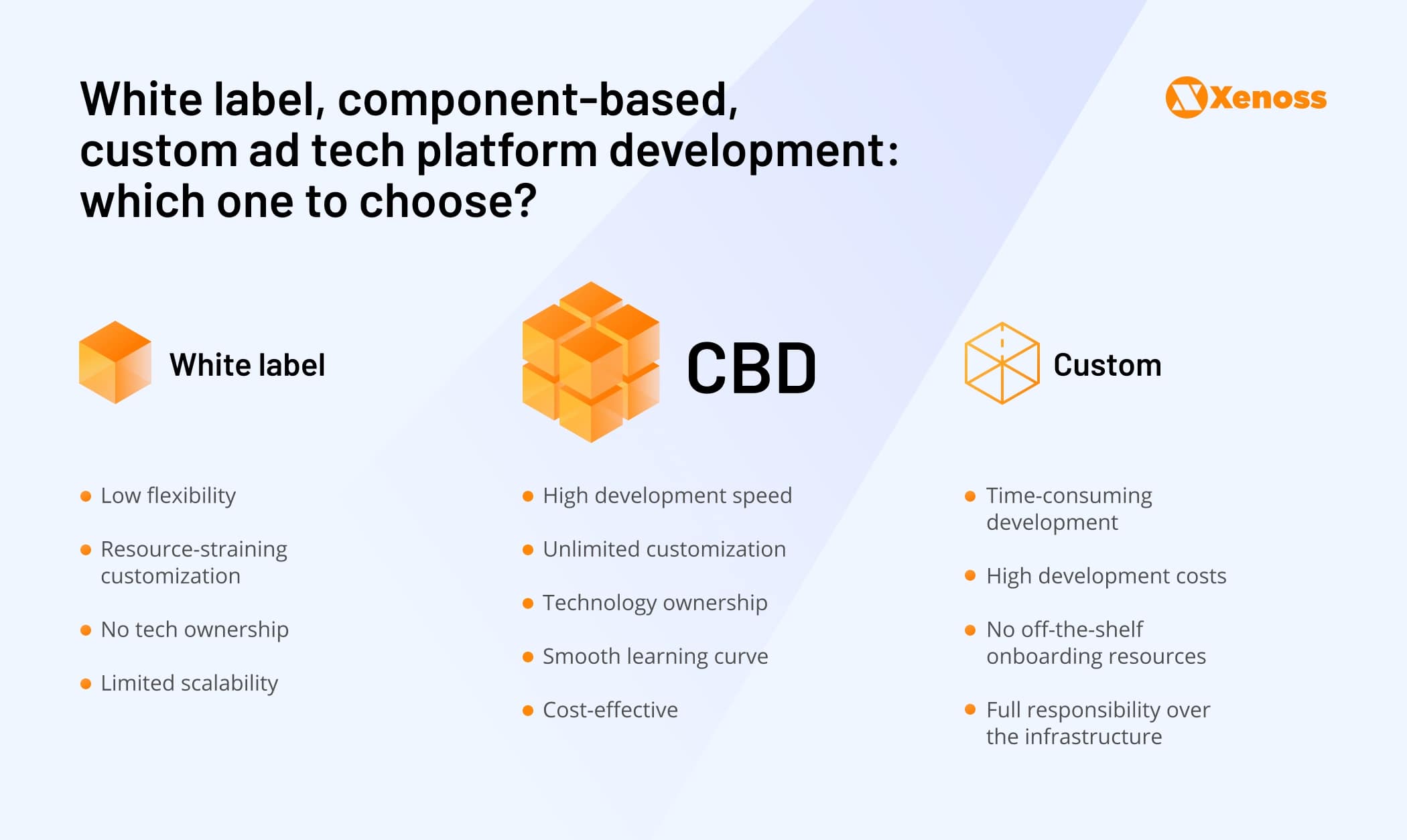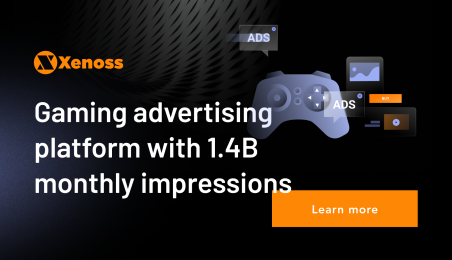Programmatic advertising has been on a meteoric rise in recent years and is expected to reach $98B in ad spend in 2021 in the US alone, accounting for almost 70% of the overall digital media advertising.
So, it’s not surprising that the thought would occur to someone to build a new AdTech solution that would better manage data, creatives, traffic, brand safety, and numerous other programmatic entities.
If you’re a startup owner or an AdTech vendor looking to expand your product line with a new solution, you are probably leaning towards solely white label options, right?
If so, we should warn you about some pitfalls you’ll likely find on your path when you go the white label route.
White label development: Crashing into the wall of inflexibility
Regardless of the specific white label solution you pick, the outcomes will be pretty similar. Count on each vendor emphasizing how their services will provide new opportunities and will eventually ease your life.
Yet, when you distill the essence from the many promises, the truth is this: by leveraging white label, you get a ready-to-use solution equipped with a basic kit of features, which can help you acquire your first customers pretty fast.
The opportunity to accelerate time to market with white labels sounds great until it comes to the pitfalls we promised to reveal to you. Here are several crucial points to consider before you’ve sealed the deal with a white label technology provider.
1. Lack of flexibility. Whatever vendors tell you, customization within white label is limited, period. It’s just a matter of time before you find yourself in dire straits due to an inability to extend your platform with new features.
2. Customization is time-consuming. Yes, this depends a great deal on the complexity of an additional feature you require. Still, extending your platform opportunities can literally take months.
3. Fine-tuning will cost you a lot. The basic kit you get off the bat may seem affordable, but each addition to it will require extra investments, which can be pretty high.
4. Low-to-no capitalization. Another crucial point to consider is that you do not own the technology. All the development, infrastructure, and APIs are on your provider’s end, which doesn’t add any value to your company if you decide to sell it one day.
5. Difficult to scale and upgrade. Most companies providing white label solutions will not give you access to the product source code or the server. As such, adding or removing functionalities is a tedious task, which will prevent you from proper scaling and timely upgrades.
And what if your white label provider is unexpectedly suspended due to GDPR violations or even worse, goes out of business due to bankruptcy? It means you lose your vital infrastructure and data.
As they say: If you don’t own your data, someone else does. As such, wouldn’t it be better to benefit from an ability to build and refine your own software and algorithms to stay ahead of competitors or increase your reach with more complex SSP integrations?
Leveraging a white label solution allows you to start fast. But lack of technological flexibility, expensive and time-consuming customization, and no added value can become stumbling blocks on your way.
Yet, it’s not the end of the story. As the tech sector of the AdTech market keeps evolving, it brings to the stage companies offering alternative ways of building advertising technology solutions.
The alternative way: Custom AdTech platform development
A bespoke AdTech software development approach means that you either build your solution in-house or outsource it to an external provider onshore or offshore. Either way, you’re getting a fully customized solution addressing your needs and your customer’s.
Along with unlimited flexibility, with custom advertising technology development, you get 100% technology ownership, and that means your business value keeps growing along with your feature-set and tech stack advancement.
However, this approach is also far from perfect.
Here’s what custom development lacks:
1. Custom software development is time-consuming
It will demand significant time before you have a chance to onboard your first customers.
2. Custom development is costly
Scalability, maintenance, enhancements, cloud migration or tech stack upgrades will require more investments and resources as your business grows.
Building a platform from the ground up empowers you with maximum flexibility and technology ownership, unlike white labels. However, it’s a lengthy and high-priced process.
Yet, there’s one more way to build your AdTech platform that would combine the best of the two worlds. It is component-based software development.
Basically, it’s the next advanced level of custom AdTech development – building a platform based on prebuilt components.
The Xenoss way: Hitting the sweet spot with component-based development
You can undoubtedly find a few service-based companies tailored specifically to AdTech solutions development.
Yet, when it comes to software houses that can build your AdTech solution based on pre-designed components, the list becomes much shorter. And Xenoss is one of such rare companies.
We’ve created dozens of AdTech solutions, from DSPs, SSPs, and ad networks to data management and customer data platforms.
The pains our clients expected to relieve and the gains they looked to get from their custom AdTech platforms have brought us to the idea of creating some kind of a prebuilt solution.
Our first try was based on a notorious white label model. And that’s, basically, how we discovered its limitations and tapped into the component-based model.
With this model, you can get your AdTech platform to market pretty fast, as using customizable code components significantly accelerates custom development and provides a basic feature set.
Here are just several examples of proprietary components we have in stock:
- The Bidding Cluster component copes with inbound RTB traffic processing, bidding for bid requests, and selecting campaigns targeting that matches inbound bid requests.
- The Predictor component analyzes campaign statistics for building prediction models, forecasting user reaction on specific ad contact.
- The DMP component is in charge of building audience segments based on analyzed user profiles.
- The Real-time Anti-Fraud component employs an ML-based system that makes a heuristic analysis of bid requests to decide whether a particular request is human- or bot-generated.
The list goes on, and so do other capacities a component-based approach brings in.
As our experience shows, up to 60% of the software product can be built with prebuilt components. This translates into significant time and cost savings.
Specifically, here’s what an AdTech vendor like you get by leveraging a component-based development.
1. Fast go-to-market
Built with predeveloped building blocks, your AdTech solution will be available to your early adopters as fast as it would work with white label.
2. Unlimited customization and flexibility
Unlike white label, this approach doesn’t have any limits in terms of customization. Whatever functionalities and opportunities you’ll need to add, you’ll have a chance to implement them all .
3. Technology ownership
You alone own the entire technology, just like in the case with building the platform from scratch.
4. Affordability
As most AdTech platforms have many standard features (like basic targeting opportunities, metrics, reporting settings, etc.), you can get plenty of prebuilt components literally instantly, and for free. That way, you pay only for what comes beyond that.
The component-based approach proves to be a sweet spot when it comes to building your AdTech platform. It delivers the fast-to-market ingredient from the white label and limitless flexibility and solution ownership from custom development.

Ready to build your AdTech solution?
Now, let’s get back to the beginning of this article. If you’re a startup owner or an AdTech vendor looking to expand your product line with a new software solution, which way would you consider now when you are aware of white label pitfalls and its alternatives?
To make a reasonable decision, consider an opportunity that lets you start fast, allocate your budget wisely, own scalable technology, and increase your business capitalization, all at once. And this is where you realize that component-based development might check off all the boxes on your wishlist.
To learn more about how you can build specifically your platform based on prebuilt components, schedule a call with us.


